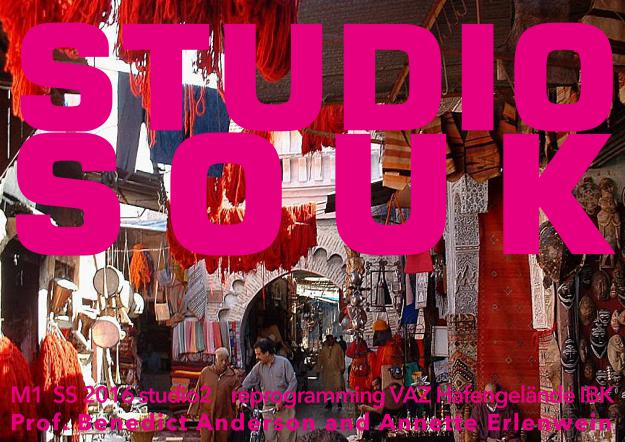EM1 Studio Souk
EM1 Studio Souk
Task
Through concept generation, iterative modelling and programming SOUK studio seeks to
appropriate the SOUK – the traditional market place of Arabic commercial activity – to create a
contemporary concept for a SOUK in the city of Innsbruck.
European Government and NGOs continue to address the vast amount of asylum seekers fleeing
warzones and economic hardship from their own countries and making their way to Europe for a
better life–free of war. Whilst most European government’s provide accommodation, food and basic
medical facilities the ability to become economically independent for full integration into European
societies needs addressing. Many asylum seekers come to Europe with varying professional, trade
and craft based skills that are not been fully utilized or integrated into the societies in which they are
now living.
The SOUK studio will be sited on the VAZ Hafen site that lies between the railway line and freeway
overpass presently used as a car park. The focus of the program will be to develop a series of microindustries
that applies the skills and knowledge of asylum seekers to allow for their integration into
the commercial, social and cultural fabric of Innsbruck. This integration will be devised as a two-way
street:
1. The asylum seekers become part of the economy but also offer language and cultural exchange
with the people of Innsbruck.
2. The City and people of Innsbruck offer a diversity of support in order to create the environment in
which to build the integration.
Program
The program is to design a contemporary Souk for the City of Innsbruck covering an area of
approximately 1,000 square meters on the vacant spaces of the VAZ Hafen site. The program should
provide no less than 8 different commodities/services/facilities. Students will work in pairs to
undertake the research, design and documentation of their Souk project. Each pair will develop their
program for a contemporary architecture of a Souk as well as its social and cultural identity.
The program should provide a diversity allowing for the Souk to transition from its daily operations to
night activities. Acting like a plug-in morphology of the Arabic Souk, the program will promote
economic independence and social osmosis between the Souk and residents of Innsbruck.
The program will have at least one or more of the following:
Services – mercantile; handcraft commodities, food market, garden, tailor, laundry, engraver, doctor
etc.
Agency – interface between Innsbruck and asylum seekers, communication, social awareness, law
representation and support to promote skills.
Education – education opportunities with existing institutions, skill exchange between asylum seekers
and people of Innsbruck, dual language classes, workshops.
Culture – exchange, meeting point, music, concerts, stage and religious facilities.
Recreation – sports, Hammam, tearoom, shisha-lounge.
Throughout the day, the Souk will operate as an integrated market system. In the evening the Souk will
offer cultural based opportunities for the residents of Innsbruck to experience: food, music, Arabic and
German language classes etc.
Providing the components for the Souk’s operations, necessary equipment for the various services
provided will need to be sourced. For example, if one aspect of the Souk is a laundry and tailor then
washing, drying, sewing machines, cutting tables and iron press etc. will need to be sourced and
layout planned. If there is provision for a medical service then equipment for a doctor’s consultation
will need to be provided as well cooking equipment for a public canteen, office and computer
equipment for IT networking and ovens for a bakery etc., small tin making workshop of tin products,
glass blowing for glass objects etc.
Each project will address forms of hybridization to create a contemporary Souk including the
building’s circulation, materiality and morphologies (structure of forms and spatial narratives). Each
project will also need to address building services including power, plumbing, lighting (natural and
incandescent) fire escape, public toilets etc. as part of the building planning.
Research
Students will conduct a wide-ranging research the origin, layout, materiality and light of the traditional
Souk as well as contemporary hybrid programming. Traditionally, the Souk provides food commodity
needs (market based provision of fruit, vegetables, spices etc.); commercial (household items, silver
and gold, money lending); social and political services (law advice etc.) and recreational (Haman etc.)
and religious. As the central market place, the Souk cuts through class and generations, creating an
overall central place for the gathering of society.
Site
VAZ Hafen. Presently used as a car park but which remains undeveloped. The site is bordered by the
railway line and freeway overpass, the Innrain and River Inn, as well as, a number of mixed use
buildings. Students will undertake a contextual site analysis: existing infrastructure, surrounding
program of buildings so as to connect and fully realize the site’s potential.
Architecture
The architecture of the Souk should embrace the notion of expansion and shrinkage as conditions
change over time. An economy of means will operate in time-line speed of the construction period (no
more than 3 months) and innovative use of materials (e.g., recycled and adaption) for your Souk
building. Students might want to consider various construction technologies such as modular design
systems and interlocking junction points that can be added to over time.


